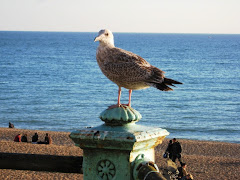
You know how it is when you want to go somewhere for an afternoon, but don't want to organise a great trek? That's when you need to know what's in your own back yard.
It's funny how people often don't visit things on their doorstep. My mother lived in Cardiff for 26 years and has never visited the Castle - which is slap bang in the middle of the city centre, and which she passed on her way to work for several years. I've now lived in London for 14 years, and usually only go to places when I have visitors: I only got around to the a trip on the London Eye a few years ago, when my brother and family visited.
So it was a pleasant surprise to spend an afternoon along the Thames in Putney recently - or should that be Fulham? Now, I'd been to Putney High Street before, for shopping and to meet friends there for drinks, but I'd not seriously thought about it as a destination for a non-shopping afternoon. But what a revelation!
Firstly, there's the river banks around Putney Bridge. The river is actually quite interesting here - a greater variety of buildings, lots of boats moored around, and the odd canoeist too (something you don't get in the centre). On the north bank is the delightful and historic church of All Saints, Fulham. Although rebuilt in the 19th century, its tower dates to 1440 and it is full of interesting memorials and monuments from the Tudor period to the late 18th Century.
Next door is Bishop's Park - a large and really delightful space. Wrapped around the impressive grounds of Fulham Palace, it has both a Thameside walk and an historic Moat walk, areas of formal park, ponds, a skating area, tennis courts, bowling greens and lots of green space for kids to let off steam (and lots of benches for granny to sit down, too. And me, come to that). There's s small cafe at the Putney Bridge end for a cuppa afterwards.
And then there's Fulham Palace itself. Once a summer retreat for the Bishops of London, parts date back to 1495, although the Bishops used it from the 11th Century onwards. The grounds are very attractive in their own right, and the Palace is used for art exhibitions as well as conferences, corporate events and weddings. The grounds still contain allotments - a relic of efforts in World War II to grow more food domestically - as well as the remains of Britain's oldest botanical garden.
Crossing the bridge back into Putney, immediately on the left there's the tower of the church of St Mary. The tower is again late mediaeval, but the interior is largely the result of Victorian rebuilding and a major reconstruction after a disastrous arson attack in 1973. It now includes a cafe and community centre, as well as an exhibition on the 'Putney Debates'. These were discussions held in the church during the English Civil War when Cromwell's Army was stationed here. They revolved around the potential forms of Government that could be adopted to replace the Monarchy. Although they had limited impact at the time, in retrospect they probably influenced the development of modern parliamentary democracy and may have influenced the content of both the Declaration of Independence and the United States' Constitution.
After all that, you'll probably need some refreshment: apart from the cafe at St Mary's, Putney has several nice pubs.
Or - you could go shopping...



No comments:
Post a Comment